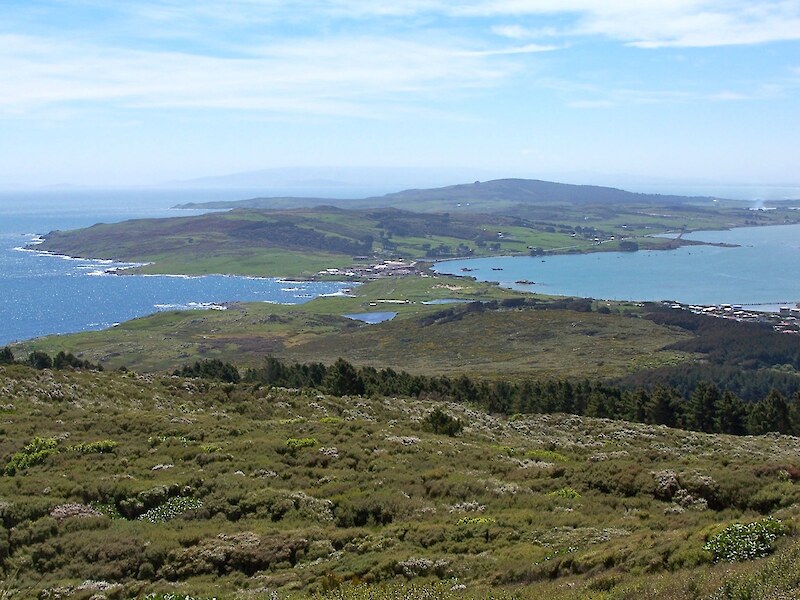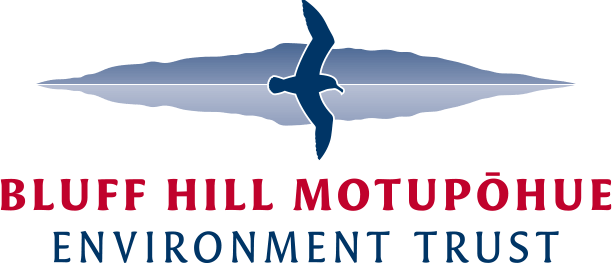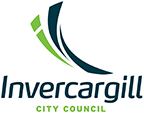About Us
BHMET was formed in early 2008 by Bluff residents concerned about the restoration of the natural environment on Motupōhue. In that year, the hill offered a beautiful forest to walk through but the forest was unnaturally silent and lacking in new growth. There was very little sign of bird or wildlife. There was little evidence of new plant life. Simply put, the forest was beautiful but it was not healthy.
Since the Trust was established, its volunteers have participated in over 50 community-led projects that have contributed to the protection or restoration of Motupōhue.
Why was the forest health so poor?
 Before: Damage to native fuchsia from possums in the Manawatu-Wanganui region. After: 9 weeks of vegetation recovery following possum control. (photo: Horizons Regional Council).
Before: Damage to native fuchsia from possums in the Manawatu-Wanganui region. After: 9 weeks of vegetation recovery following possum control. (photo: Horizons Regional Council). Possums eat land snails by biting through the shell and pulling the snail out. (Photo: DOC Te Papa Atawahi 2014)Pest animals were to blame. The forest was teeming with rats, possums, mustelids (stoats, ferrets and weasels) and feral cats. They ate the birds, their chicks and eggs, the invertebrates and the vegetation from the canopy to the forest floor. These animals were doing what came naturally to them but not natural to the Hill. These animals are introduced species not indigenous to New Zealand. Today the forest health is better.
Possums eat land snails by biting through the shell and pulling the snail out. (Photo: DOC Te Papa Atawahi 2014)Pest animals were to blame. The forest was teeming with rats, possums, mustelids (stoats, ferrets and weasels) and feral cats. They ate the birds, their chicks and eggs, the invertebrates and the vegetation from the canopy to the forest floor. These animals were doing what came naturally to them but not natural to the Hill. These animals are introduced species not indigenous to New Zealand. Today the forest health is better.
A walk in the forest is now accompanied by the sounds and sights of bellbird/korimako, fernbird/mātātā, red-crowned parakeet/kākāriki, tui/koko, shining cuckoo/pīpīwharauroa, to name a few. The ancient Southern Rata, Rimu, Miro and Hall’s Totara now look down upon a diverse and thriving forest floor, where birds and invertebrates feed among the undergrowth and forest debris. The coastal Foveaux Walkway overlooks the homes of Sooty Shearwater/Titi, Little Blue Penguin/ kororā and at least four species of Shag.
 Network map. Click to enlarge.Why is the forest health better?
Network map. Click to enlarge.Why is the forest health better?
Over the last ten years, BHMET has successfully established a network of 450 rat bait stations, 450 rat traps and 240 possum traps over the 204 hectares of the Bluff Hill Motupōhue Scenic Reserve. BHMET has also established a network of 140 mustelid traps throughout the Reserve and the surrounding 436 hectares of manuka, flax, fernland and farmland. We established 48 possum traps outside the scenic reserve in two places where possum tracking results were high. BHMET also established a line of 30 mustelid traps across the harbour from Joey’s Island/Ka Kau Taupapa to Pikaroroa Island. Outside the Bluff township we established a line of 5 mustelid traps along the Greenpoint walkway/boardwalk and 4 possum traps, and 16 mustelid traps at the Flat Hill Windfarm/Turakanui A Rua. More recently, the Protect the Bluff back yard trapping program has added another 300 traps in the Bluff community. That’s a whopping 2,000 total pest control devices on and around Motupōhue! We’ve brought the number of pest animals down to very low levels. No longer do you see mustelids running around, possum browse on trees or rats popping up here and there. All you see now is the forest’s beautiful biodiversity. Click HERE to see a map of our mustelid line network on Bluff HIll.
 With this successful reduction in pest animals, the birds have thrived. In December 2015, the 5-minute bird counts took place over 20 stations on Bluff Hill on 3 different days; the average count over those three days was 183; back in December 2008 the 5-minute count took place over 20 stations on one day; the total count was 116. The Titi (muttonbird) colonies on Bluff Hill are some of the few remaining mainland colonies left in the country. In 2008, BHMET conducted feral cat trapping around the colonies. That year and every year since, the Trust monitors the colonies by counting chicks in known burrows and locating any new burrows. The results are extremely promising with birds numbers increasing slowly but steadily. Insects area also thriving. Environment Southland (who does pest animal tracking for us) reports that the number of weta tracks has increased on the tracking cards used to monitor rat numbers. Weta are a good indicator species for the sucess of pest animal management. BHMET has received numerous personal accounts from locals of increased bird and insect life on the hill and on their own properties.
With this successful reduction in pest animals, the birds have thrived. In December 2015, the 5-minute bird counts took place over 20 stations on Bluff Hill on 3 different days; the average count over those three days was 183; back in December 2008 the 5-minute count took place over 20 stations on one day; the total count was 116. The Titi (muttonbird) colonies on Bluff Hill are some of the few remaining mainland colonies left in the country. In 2008, BHMET conducted feral cat trapping around the colonies. That year and every year since, the Trust monitors the colonies by counting chicks in known burrows and locating any new burrows. The results are extremely promising with birds numbers increasing slowly but steadily. Insects area also thriving. Environment Southland (who does pest animal tracking for us) reports that the number of weta tracks has increased on the tracking cards used to monitor rat numbers. Weta are a good indicator species for the sucess of pest animal management. BHMET has received numerous personal accounts from locals of increased bird and insect life on the hill and on their own properties.
What more will BHMET do to promote forest health?
We’ll continue to fine tune and increase our pest control. We’ll start a backyard trapping programme in Bluff. We’ll establish a community native plant nursery to provide seedlings to boost the vegetation recovery on the hill and harbour environs. We’ll translocate birds species that are missing on our hill. We’ll continue to educate children and adults about the importance of forest health and the ways they can contribute. We’ll increase non-pest animal monitoring to further measure our success in pest control. We’ll establish guided forest walks and Titi colony viewings to support growth of the Bluff economy through these eco-tourism opportunities.
More about BHMET
 Volunteers (l-r) Marion Metz, Mitch Bartlett and Emily Osborne readying a penguin for relocation to a safer area along the Bluff Hill coastline.BHMET has a 100% volunteer workforce including it’s Trustees. Our volunteers work individually or in groups to maintain our pest control network and to carry out management and administrative duties. BHMET entered into a Management Agreement with the Department of Conservation (DOC) and the Invercargill City Council (ICC) to undertake environmental restoration in the Bluff Hill area. Support from DOC and ICC has been and continues to be highly beneficial in both advisory and financial support capacities. Environment Southland (ES) carries out all the pest animal tracking and bird counts that provide us with population growth or decline. This information helps us understand how well our pest control is working and when we need to make adjustments. ES also provides us with supplies or equipment for special projects and their advisory and financial support. Our work is fully funded through donations, grants and fund-raising events, the largest of which is donations.
Volunteers (l-r) Marion Metz, Mitch Bartlett and Emily Osborne readying a penguin for relocation to a safer area along the Bluff Hill coastline.BHMET has a 100% volunteer workforce including it’s Trustees. Our volunteers work individually or in groups to maintain our pest control network and to carry out management and administrative duties. BHMET entered into a Management Agreement with the Department of Conservation (DOC) and the Invercargill City Council (ICC) to undertake environmental restoration in the Bluff Hill area. Support from DOC and ICC has been and continues to be highly beneficial in both advisory and financial support capacities. Environment Southland (ES) carries out all the pest animal tracking and bird counts that provide us with population growth or decline. This information helps us understand how well our pest control is working and when we need to make adjustments. ES also provides us with supplies or equipment for special projects and their advisory and financial support. Our work is fully funded through donations, grants and fund-raising events, the largest of which is donations.
In 2013, BHMET entered into a 3 year partnership with Blacks Fasteners part of which is to establish a native plant nursery in Bluff. Currently the Trust’s nursery resides in the back yard of our Co-Chair for Conservation. The Trust has purchased a section in Bluff for the nursery. The nursery will provide native plants to boost vegetation recovery on Bluff hill, Bluff harbour islands and for donations to environmental restoration groups/organisations.
 Estelle Leask with Billy the dog (both volunteers) gave a tour of our work on Bluff Hill to students from Southland Girls High School. The girls even found a couple of dead rats in our traps. Score!BHMET trustees and volunteers give on-site tours and yearly presentations on our work to schools, Southland Institute of Technology (SIT) and community groups. We also offer study opportunities to SIT environmental management students and run a 2-day working bee with an overnight stay hosted by the Te Rau Aroha Marae. Research studies already completed by students are the study of freshwater invertebrates in the hill’s pools and reservoirs and the study of the hill’s fernbird colony.
Estelle Leask with Billy the dog (both volunteers) gave a tour of our work on Bluff Hill to students from Southland Girls High School. The girls even found a couple of dead rats in our traps. Score!BHMET trustees and volunteers give on-site tours and yearly presentations on our work to schools, Southland Institute of Technology (SIT) and community groups. We also offer study opportunities to SIT environmental management students and run a 2-day working bee with an overnight stay hosted by the Te Rau Aroha Marae. Research studies already completed by students are the study of freshwater invertebrates in the hill’s pools and reservoirs and the study of the hill’s fernbird colony.
BHMET supports other conservation groups and schools. BHMET donated native plants for restoration or landscaping to the Dog Island Restoration project and the Bluff 2024 Rejuvenation project. We also made a monetary donation to the Million Dollar Mouse project. The Trust helped to establish a native plant nursery at Bluff School.
BHMET took the Omaui Landcare Group (OLG) under their umbrella in March 2013. We provided funds for traps and field supplies and, by June 1st, OLG installed a network of 32 possum traps in the ICC Reserve at Omaui. After their successful kick-start under our umbrella, OLG developed a comprehensive restoration strategy for the DOC Scenic Reserve, the ICC Reserve and surrounding coastal environment in Omaui. OLG is now operating independently as the Omaui Landcare Charitable Trust (OLCT). BHMET made a cash donation in 2014 to facilitate their beginning as a registered Trust. Our investment has been a worthwhile venture – not only is OLCT doing great environmental restoration but with protected forests in Omaui and Bluff, there will be less pest incursion into and out of both areas and our birds will have safe havens at either end of our little peninsula.
 Greenhills and Omaui as seen from Bluff HillAwards
Greenhills and Omaui as seen from Bluff HillAwards
- 2009: Winner, Heritage and Environment, Trustpower Community Awards
- 2009: Certificate of Congratulations for our Commitment to Maintain and Enhance the Invercargill Environment, Invercargill City Council
- 2010: Highly Commended Community Group Award, Southland Environment Awards
- 2010: Services to Conservation with Communities Award, Southland Conservation Awards
- 2011: Joint Regional Runner-Up, Heritage and Environment, Trustpower Community Awards
- 2013: Regional Winner, Heritage and Environment, Trustpower Community Awards
- 2014: Highly Commended Community Group Award, Southland Environment Awards
- 2017: Winner, Environment Southland Award - Environmental Action in the Community
Our objectives
 Enchanted walkway lives up to it's name: The Glory Track. (photo: Joel Ryan)To provide a safe environment around Bluff Hill for the survival and increase of native species through sustained control of introduced pest animals.
Enchanted walkway lives up to it's name: The Glory Track. (photo: Joel Ryan)To provide a safe environment around Bluff Hill for the survival and increase of native species through sustained control of introduced pest animals.- To inspire and enthuse our local community and visitors about their ability to make a difference to this special place.
- To maintain an up-to-date knowledge-base in the community about environmental protection by maintaining close relationships with local government agencies, community-based environmental groups around NZ and by facilitating research through local educational institutions.
- To provide for the sustainable growth of the Bluff economy through enhancing tourism and eco-tourism opportunities.
- To foster pride in our community and the environment around Bluff Hill.
- In the long term, to provide a safe environment for the re-introduction of native species which have disappeared from the area over time, including those which self-introduce from nearby sanctuaries.
- To protect the native forest and the species that rely on it by removing pest weeds.



